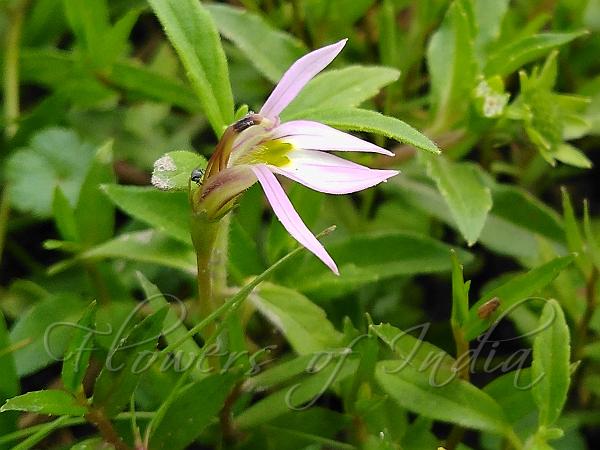|
| Chinese Lobelia |
|

|

| File size | 499842 |
| Original date | 9/21/20 11:40 AM |
| Resolution | 4000 x 3000 |
| Flash | Flash did not fire, auto |
| Focal length | 3.819mm |
| Exposure time | 1/345s |
| Aperture | 2.2 |
| Focus Distance | |
| Metering Mode | Center weighted average |
| Camera make | Xiaomi |
| Camera model | Redmi Note 5 |
| Sensor type | OneChipColorArea |
|
|
|
|
Photo: |
Botanical name: Lobelia chinensis Family: Campanulaceae (Bell flower family)
Synonyms: Lobelia campanuloides, Lobelia japonica, Lobelia roxburghiana
Synonyms: Lobelia campanuloides, Lobelia japonica, Lobelia roxburghiana
Chinese Lobelia is a perennial herb with stems
prostrate, slender, 6-30 cm tall, hairless, lower nodes rooted. Flowers
are rose, white, or bluish, 1-1.5 cm, divided to base at back, white
hairy below throat; petals all spreading in a plane on anterior side;
lateral 2 petals lanceshaped or inverted-lanceshaped, longer than
others, central 3 elliptic. Filament tube is 6-8 mm, fused above
middle, anther tube 2-2.5 mm. Sepal-cup is narrowly obconical, base
narrowed, not well distinguished from flower-stalk, 3-5 mm, hairless;
sepals lanceshaped, as long as tube, margin entire or with a pair of
denticles. Flowers are usually solitary, in leaf-axils at upper leaves
of branches. Flower-stalks are slender, 1.2-2.5 cm. Leaves are
alternate, stalkless or nearly so, blade narrowly elliptic, elliptic,
or lanceshaped, 7-26 x 1.5-7 mm, hairless, base rounded, blunt, or
broadly wedge-shaped, margin entire or obviously sawtoothed at upper
part, tip pointed or tapering.Capsule is obconic, 6-7 mm. Chinese
Lobelia is found in Central Himalaya to Japan. Flowering: May-October.
Medicinal uses: Chinese Lobelia is considered
one of the 50 fundamental herbs in Chinese herbology. The whole plant
is antiphlogistic, depurative, diuretic and febrifuge. Taken as an
alcoholic macerate, it is used as a lung tonic and for the treatment of
tuberculosis, asthma and bloody vomiting. A strong decoction is taken
as a diuretic and cathartic; it can stimulate respiration, lower the
blood pressure, stop bleeding and reduce swellings. Applied externally
as a decoction or as a poultice of the fresh leaves, it is used in the
treatment of swellings, sores and abscesses; the bites and stings of
poisonous insects and animals; tooth abscesses, ascites and traumatic
injuries. The fresh plant can also be crushed and used as a poultice.
Chinese Lobelia is considered
one of the 50 fundamental herbs in Chinese herbology. The whole plant
is antiphlogistic, depurative, diuretic and febrifuge. Taken as an
alcoholic macerate, it is used as a lung tonic and for the treatment of
tuberculosis, asthma and bloody vomiting. A strong decoction is taken
as a diuretic and cathartic; it can stimulate respiration, lower the
blood pressure, stop bleeding and reduce swellings. Applied externally
as a decoction or as a poultice of the fresh leaves, it is used in the
treatment of swellings, sores and abscesses; the bites and stings of
poisonous insects and animals; tooth abscesses, ascites and traumatic
injuries. The fresh plant can also be crushed and used as a poultice.
Medicinal uses:
 Chinese Lobelia is considered
one of the 50 fundamental herbs in Chinese herbology. The whole plant
is antiphlogistic, depurative, diuretic and febrifuge. Taken as an
alcoholic macerate, it is used as a lung tonic and for the treatment of
tuberculosis, asthma and bloody vomiting. A strong decoction is taken
as a diuretic and cathartic; it can stimulate respiration, lower the
blood pressure, stop bleeding and reduce swellings. Applied externally
as a decoction or as a poultice of the fresh leaves, it is used in the
treatment of swellings, sores and abscesses; the bites and stings of
poisonous insects and animals; tooth abscesses, ascites and traumatic
injuries. The fresh plant can also be crushed and used as a poultice.
Chinese Lobelia is considered
one of the 50 fundamental herbs in Chinese herbology. The whole plant
is antiphlogistic, depurative, diuretic and febrifuge. Taken as an
alcoholic macerate, it is used as a lung tonic and for the treatment of
tuberculosis, asthma and bloody vomiting. A strong decoction is taken
as a diuretic and cathartic; it can stimulate respiration, lower the
blood pressure, stop bleeding and reduce swellings. Applied externally
as a decoction or as a poultice of the fresh leaves, it is used in the
treatment of swellings, sores and abscesses; the bites and stings of
poisonous insects and animals; tooth abscesses, ascites and traumatic
injuries. The fresh plant can also be crushed and used as a poultice.
| Identification credit: Niku Das | Photographed in Monabarie T.E., Sonitpur, Assam. |
• Is this flower misidentified? If yes,